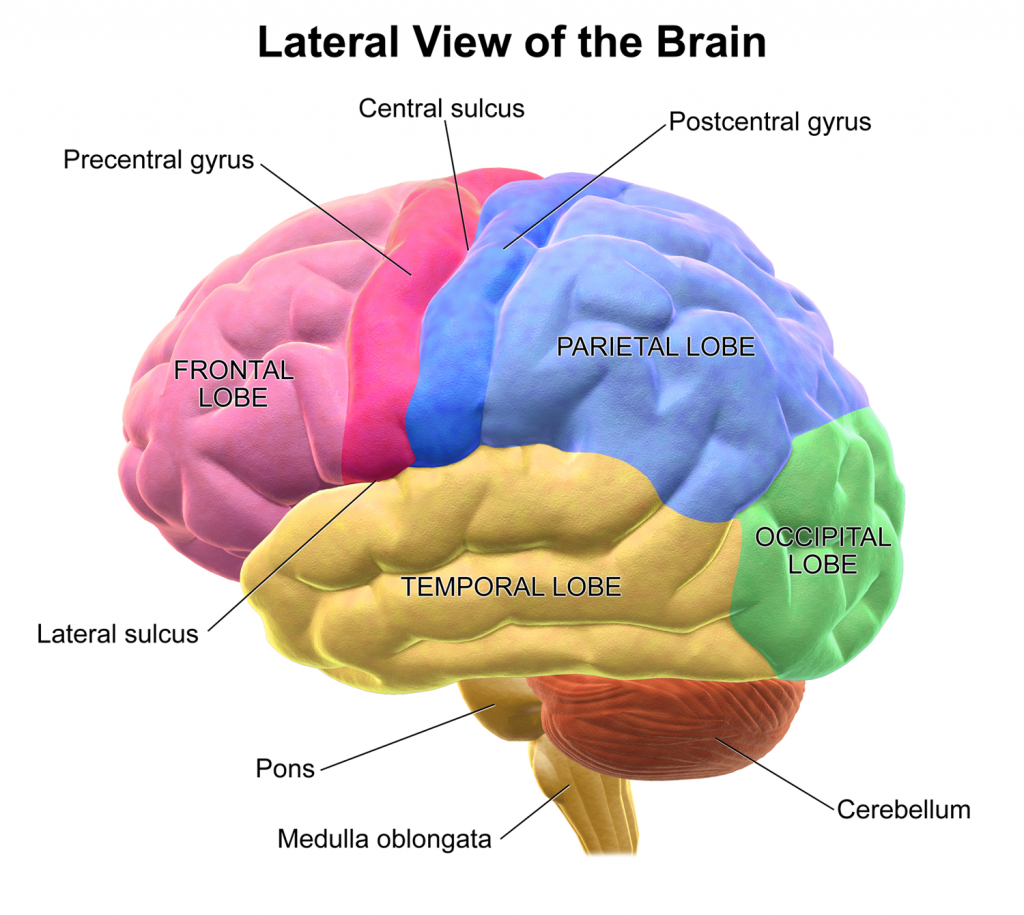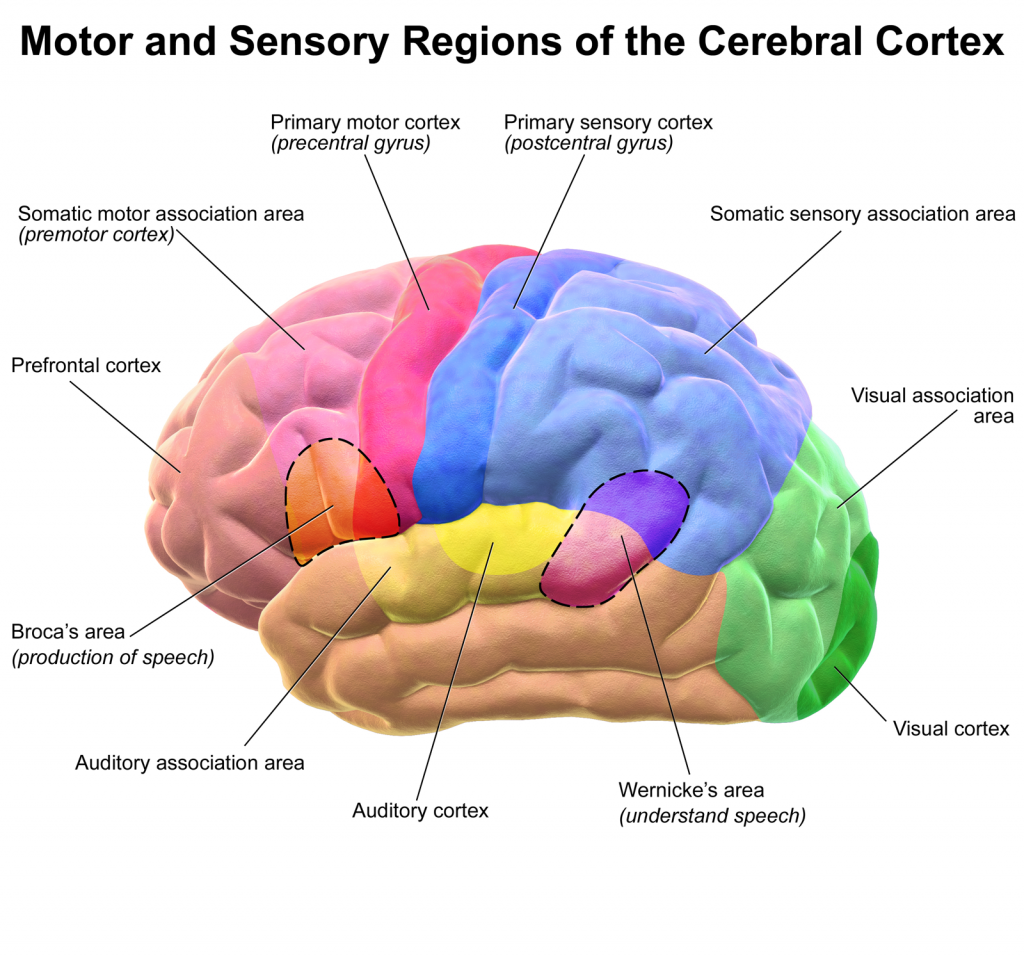
Anatomy
This was previously featured in an exam
Central Nervous System
A 69 year old patient is brought to ED with acute onset facial weakness on the right side, and difficulty with speech. He is able to respond to questions appropriately by nodding or shaking his head, but he uses only a few words that are jumbled and don't make sense. Which of the following lobes has been affected:
Answer:
Right sided facial weakness and expressive dysphasia is most likely caused by a lesion to the left frontal lobe, due to damage to the primary motor cortex and the Broca speech area respectively.Frontal Lobe
Anatomy / Central Nervous System
Last Updated: 19th February 2019
The frontal lobe extends from the central sulcus to the frontal pole. It is separated from the parietal lobe posteriorly by the central sulcus and from the temporal lobe inferoposteriorly by the lateral sulcus.

Lobes of the Brain. (Image by BruceBlaus (Own work) [CC BY 3.0 , via Wikimedia Commons)
Function
Areas of the frontal lobe are responsible for:
- Movement (planning and execution)
- Higher intellect, problem solving and judgement
- Attention and concentration
- Behaviour, personality and mood
- Language production
- Continence
Cortical Areas
Table: Cortical Areas of the Frontal Lobe
| Area | Function | Lesion |
|---|---|---|
| Primary motor cortex | Contralateral movement of voluntary muscles | Contralateral UMN weakness/paralysis |
| Premotor cortex | Role in coordination of complex movements | Apraxia, UMN signs |
| Supplementary motor cortex | Role in programming complex motor sequences | Inability to plan sequence of complex movements |
| Frontal eye field | Conjugate deviation of the eyes to the opposite side | Conjugate deviation of the eyes towards the side of the lesion (and away from the side of weakness) |
| Broca speech area (dominant hemisphere) | Speech production | Expressive dysphasia |
| Prefrontal cortex | Higher intellect, problem-solving, judgement, personality, emotion and mood, central control of micturition | Inappropriate social behavior, difficulty in adaptation and loss of initiative, primitive reflexes, inability to concentrate, incontinence |
- The primary motor cortex is located in the precentral gyrus and is responsible for voluntary movements of muscles of the opposite side of the body.
- The premotor cortex plays a role in the control and coordination of proximal and axial muscles, it prepares the motor cortex for specific movements in advance of their execution.
- The supplementary motor cortex is concerned with programming of complex movements and regulates somatosensory input into the motor cortex.
- The Broca speech area (in the dominant hemisphere only) is the 'expressive' centre for the production of speech. It is connected to the Wernicke speech area by the arcuate fasciculus.
- The frontal eye field is involved in making eye movements to the contralateral side.
- The prefrontal cortex governs personality, emotional expression, initiative and the ability to plan.
- The cortical micturition centre, within the prefrontal cortex, is involved in the cortical inhibition of the voiding of the bladder.

Motor and Sensory Regions of the Cerebral Cortex. (Image by Blausen.com staff. “Blausen gallery 2014, via Wikimedia Commons)
Blood Supply
The blood supply to the frontal lobe is from the anterior cerebral artery (supplying the medial surface of the primary motor cortex which controls the lower limb) and the middle cerebral artery (supplying the lateral surface of the primary motor cortex which controls the face and upper limb).
![By derivative work: Frank Gaillard (talk) Brain_stem_normal_human.svg: Patrick J. Lynch, medical illustrator (Brain_stem_normal_human.svg) [GFDL 1.3 (www.gnu.org/licenses/fdl-1.3.html), GFDL 1.3 (www.gnu.org/licenses/fdl-1.3.html), CC BY-SA 3.0 (http://creativecommons.org/licenses/by-sa/3.0) or CC BY 2.5 (http://creativecommons.org/licenses/by/2.5)], via Wikimedia Commons](https://primary-cdn.frcemsuccess.com/wp-content/uploads/2017/01/Cerebral-Vascular-Territories-1-1.jpg)
Cerebral Blood Supply. (Image by derivative work: Frank Gaillard (talk) Brain_stem_normal_human.svg: Patrick J. Lynch, medical illustrator (Brain_stem_normal_human.svg) [GFDL 1.3 (www.gnu.org/licenses/fdl-1.3.html), via Wikimedia Commons)
Clinical Implications
Damage to the frontal lobe may cause a diverse range of presentations including:
- contralateral weakness/paralysis in an UMN pattern (damage to the primary motor cortex)
- inability to plan sequence of complex movements (damage to the premotor cortex and supplementary motor cortex)
- conjugate eye deviation where both eyes look towards the side of the lesion and away from the side of weakness (damage to the frontal eye field)
- expressive dysphasia (damage to the Broca speech area)
- personality, mood and behavioural change with loss of initiative and inability to problem solve (damage to the prefrontal cortex)
- primitive reflexes (damage to the prefrontal cortex)
- anosmia (damage to the olfactory tract as a result of close proximity to inferior frontal lobe)
- incontinence (damage to the cortical micturition centre)

Cortical Language Areas. (Image by Peter Hagoort [CC BY 3.0 , via Wikimedia Commons)
Report A Problem
Is there something wrong with this question? Let us know and we’ll fix it as soon as possible.
Loading Form...
- Biochemistry
- Blood Gases
- Haematology
| Biochemistry | Normal Value |
|---|---|
| Sodium | 135 – 145 mmol/l |
| Potassium | 3.0 – 4.5 mmol/l |
| Urea | 2.5 – 7.5 mmol/l |
| Glucose | 3.5 – 5.0 mmol/l |
| Creatinine | 35 – 135 μmol/l |
| Alanine Aminotransferase (ALT) | 5 – 35 U/l |
| Gamma-glutamyl Transferase (GGT) | < 65 U/l |
| Alkaline Phosphatase (ALP) | 30 – 135 U/l |
| Aspartate Aminotransferase (AST) | < 40 U/l |
| Total Protein | 60 – 80 g/l |
| Albumin | 35 – 50 g/l |
| Globulin | 2.4 – 3.5 g/dl |
| Amylase | < 70 U/l |
| Total Bilirubin | 3 – 17 μmol/l |
| Calcium | 2.1 – 2.5 mmol/l |
| Chloride | 95 – 105 mmol/l |
| Phosphate | 0.8 – 1.4 mmol/l |
| Haematology | Normal Value |
|---|---|
| Haemoglobin | 11.5 – 16.6 g/dl |
| White Blood Cells | 4.0 – 11.0 x 109/l |
| Platelets | 150 – 450 x 109/l |
| MCV | 80 – 96 fl |
| MCHC | 32 – 36 g/dl |
| Neutrophils | 2.0 – 7.5 x 109/l |
| Lymphocytes | 1.5 – 4.0 x 109/l |
| Monocytes | 0.3 – 1.0 x 109/l |
| Eosinophils | 0.1 – 0.5 x 109/l |
| Basophils | < 0.2 x 109/l |
| Reticulocytes | < 2% |
| Haematocrit | 0.35 – 0.49 |
| Red Cell Distribution Width | 11 – 15% |
| Blood Gases | Normal Value |
|---|---|
| pH | 7.35 – 7.45 |
| pO2 | 11 – 14 kPa |
| pCO2 | 4.5 – 6.0 kPa |
| Base Excess | -2 – +2 mmol/l |
| Bicarbonate | 24 – 30 mmol/l |
| Lactate | < 2 mmol/l |

